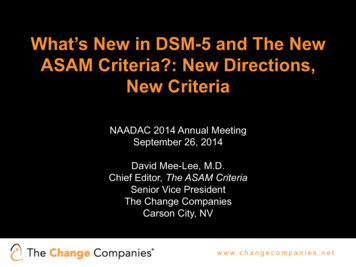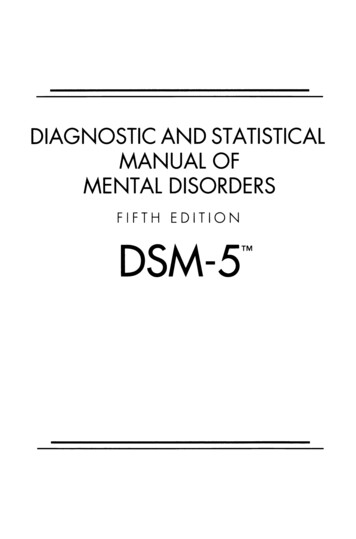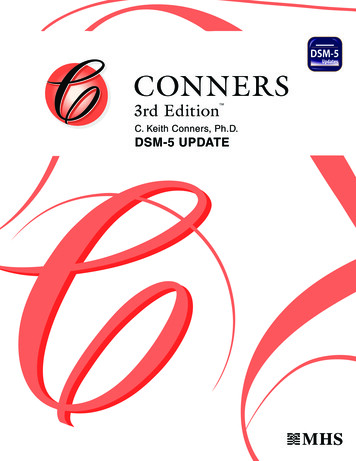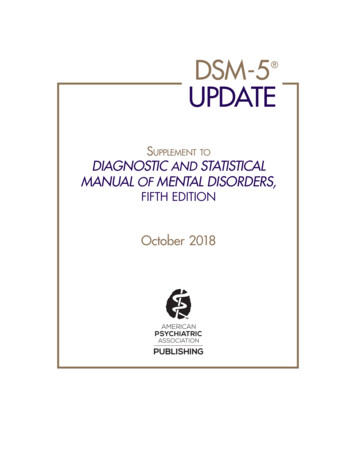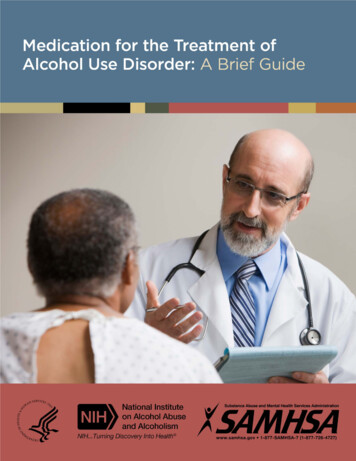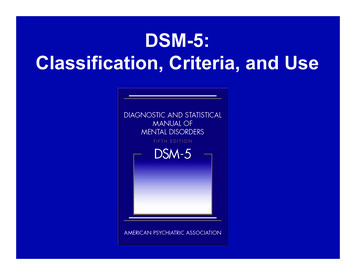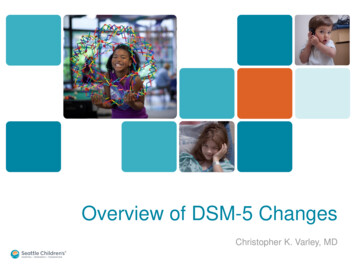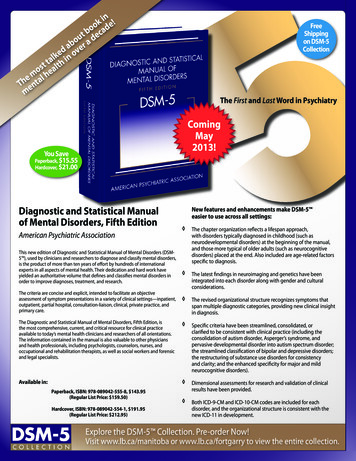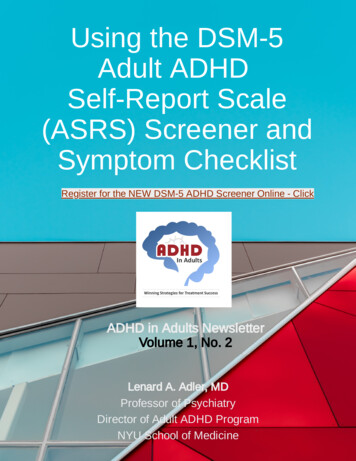
Transcription
Using the DSM-5Adult ADHDSelf-Report Scale(ASRS) Screener andSymptom ChecklistRegister for the NEW DSM-5 ADHD Screener Online - ClickADHD in Adults NewsletterVolume 1, No. 2Lenard A. Adler, MDProfessor of PsychiatryDirector of Adult ADHD ProgramNYU School of Medicine
Using the DSM-5 Adult ADHD Self-Report Scale (ASRS) Screenerand Symptom ChecklistFrom the Editor:Welcome to the 2nd Issue of Volume 1 of the Using DSM-5 Adult ADHD Self-ReportScale (ASRS) Screener and Symptom Checklist Newsletter. In our first issue wereviewed the history of the development of the ASRS Symptom Checklist and DSM-IVScreener.In this issue we will present the science behind the DSM-5 version of the Screener, thepsychometric properties of the screener, describe the screener itself and indicate wherethe screener can be obtained.The DSM-5 ASRS Screener offers substantial advantages over earlier versions of thescreener in multiple ways, including: 1) updating to and utilizing DSM-5 adult ADHDcriteria, 2) including a large referred sample of controls and adult controls in the validationprocess, 3) having two symptoms of executive function deficits as part of the ADHDScreener, 4) utilization of artificial intelligence to assist in the weighting of symptomscoring and 5) availability of electronic scoring of the screener.This volume also includes a sample case of a model patient being evaluated for adultADHD, which illustrates how the DSM-5 ASRS Screener can be utilized.I trust that you will find the advances of the new version of the Screener not only at theforefront of clinical science, but also of healthcare delivery. The goal is to improve theappropriate identification of adults with ADHD.Lenard A. Adler MDProfessor of PsychiatryDirector of Adult ADHD Program NYU School of MedicineADHD in Adults Newsletter Volume 1, No. 1Page 1
Using the DSM-5 Adult ADHD Self-Report Scale (ASRS) Screenerand Symptom ChecklistDSM-5 and its Updates:DSM-5, published in 2013 improved the prior diagnostic criteria in several ways by:1) Reducing the number of required symptoms for those 17 years of age or older frommore than six to more than five inattentive and/or hyperactive-impulsive symptoms);2) Requiring that several significant symptoms had to occur in more than one setting priorto age 12;3) Raising the age at onset from 7 to 12;4) Adding examples for each symptom to help understand adult presentations.ADHD in Adults Newsletter Volume 1, No. 1Page 2
Using the DSM-5 Adult ADHD Self-Report Scale (ASRS) Screenerand Symptom ChecklistOf note, these new criteria did not include symptoms of executive function deficits oremotional dyscontrol (EFD or EC, respectively); EFD are symptoms of higher-levelorganization, working memory, prioritization and planning which commonly co-exist withsymptoms of adult ADHD and are substantially impairing. EC symptoms also commonlyco-travel with adult ADHD and are symptoms of moodiness and a changeable mood(1).The lack of inclusion of EFD symptoms will become an important point when we discussthe development of the new screener for adult ADHD for DSM-5 in future newsletters.Ustun et al. (2017)(2) recently published an updated version of the adult ADHD screenerwhich is validated for DSM-5: the ASRS v1.1 Screener: DSM-5. The prior DSM-IV versionof the screener was established using two populations: a community-based sample fromthe National Co-Morbidity Survey (NCS-R) and a sample of individuals from a health careplan.The first step was to recalibrate the new screener using these same two samples, butapplying updated DSM-5 criteria; symptoms included not only core symptoms ofinattention (IA) and hyperactivity-impulsivity (HI) as defined in DSM, but additional cotraveling symptoms of executive dysfunction (eg: deficits in organization, planning,working memory) or emotional dysregulation (eg: over emotionality, changeable mood).The symptoms of executive dysfunction have been shown to carry a high symptomburden and in many ways drive the symptom presentation when present in a recent factoranalysis(1). The selection and weighting of the symptoms was selected by SLIM artificialintelligence – six items were selected: four were from DSM classic symptoms of IA andHI, but two were symptoms of executive dysfunction beyond those defined in the DSM.ADHD in Adults Newsletter Volume 1, No. 1Page 3
Using the DSM-5 Adult ADHD Self-Report Scale (ASRS) Screenerand Symptom ChecklistThe process was again repeated and validated in a new sample of referred individuals forADHD evaluations and controls from primary care practices from the NYU School ofMedicine as second validation. The screener is again self-report and rated on a frequencybasis of 0-4 (never to very often), with a cut-off score of 14 indicating a positivescreen. The weighting of items in the screener is not evenly distributed and the scoringalgorithm will shortly be available through an educational program on this website.The ASRS v1.1 Sceener: DSM-5 has a high degree of sensitivity and specificity (firstsample: 91.4%; 96.0%, respectively; second NYU sample: 91.9%, 74.0%, respectively).Given the high sensitivity and specificity, the new screener can be a highly effective toolfor clinicians to identify individuals at risk for adult ADHD who merit further evaluation anda full diagnostic evaluation.(1, 2).Reviewing the DSM-5 ASRS Screener:ADHD in Adults Newsletter Volume 1, No. 1Page 4
Using the DSM-5 Adult ADHD Self-Report Scale (ASRS) Screenerand Symptom ChecklistThe cut-point of a total score of 14 or greater was chosen because it maximized the areaunder the receiver operating characteristic curve (AUC) when compared with otherthreholds. These data are seen in the chart below.SLIM (a machine learning algorithm) was then used to establish the optimal number ofquestions and which questions from not only the 18 DSM symptoms but an additional 13EFD and EC items, which as noted above commonly co-occur in adult ADHD and cancause significant impairment but are not in the DSM. The new DSM-5 ASRS Screenerhas four DSM items, four of which assess EFD.ADHD in Adults Newsletter Volume 1, No. 1Page 5
Using the DSM-5 Adult ADHD Self-Report Scale (ASRS) Screenerand Symptom ChecklistThe items in the screener are given below:ADHD in Adults Newsletter Volume 1, No. 1Page 6
Using the DSM-5 Adult ADHD Self-Report Scale (ASRS) Screenerand Symptom ChecklistThe scoring algorithm is weighted based on the value of each item for discriminatingpeople with and without ADHD. It and can most easily be scored electronically.Clinicians are encouraged to access and use theDSM-5 ADHD Online Screener here at no charge - CLICK.Editor’s Comments on Use of The DSM-5 ASRS Screener:The new screener offers significant advantages over the prior version. These advantagesare:1. validation with the new diagnostic criteria in DSM-5 (although the DSM-IV versioncan still be used, its psychometric properties are not as robust as the new version)2. inclusion of two EFD items, as many studies have shown the importance of EFDsymptoms in adult ADHD3. the weighted scoring of the scale. As all items do not carry the same level of inputinto screening positive, the more sophisticated scoring system developed withmachine learning matches clinician’s observations that not all symptoms are of equalimport4. validation using, not only community and managed care samples, but also a referredsampleThe new screener offers primary care physicians, nurse practitioners, psychiatrists,psychologists and other health professionals the ability to use their time efficiently andidentify patients at risk for having adult ADHD. Patients who screen positive shouldreceive a thorough diagnostic evaluation to establish whether they truly have thediagnosis. Individuals who screen negative are highly unlikely to have adult ADHD basedon the very high specificity of the test.ADHD in Adults Newsletter Volume 1, No. 1Page 7
Using the DSM-5 Adult ADHD Self-Report Scale (ASRS) Screenerand Symptom ChecklistIn addition to using the screener, clinicians can use the 18 item ASRS Symptom Checklistto obtain a full symptom inventory atbaseline, which can assist in the diagnosticevaluation. The checklist can also be used to monitor treatment response. Futureissues ofthe newsletter will discuss in further detail the use and validation of the full DSM5 ASRSSymptom Checklist.Case Study:The patient, PY, is a 40-year-old male construction worker, who is married with threechildren. He was diagnosed with ADHD as a child and treated with methylphenidateimmediate release until early in high school when he chose to discontinue treatment.Significant symptoms were noted of interrupting parents and teachers, being in and out ofhis chair, and not listening, which go back to elementary school.PY has been off medication for over 20 years - presents for help after his 10 year old sonwas diagnosed with ADHD. The patient describes a many year history of inattention,easy distraction, and restlessness (runs 6 miles a day to “get energy out".)He feels his job in construction helps (as he moves). He has inability to wait (multipletraffic tickets for speeding and MVAs), inability to turn off (can’t relax on vacation or atnight). He depends on his wife to plan his life and is unable to sit through religiousservices.You believe the patient may be at risk for ADHD and administer the DSM-5 ASRSScreener. His results are as follows in the next two slides:ADHD in Adults Newsletter Volume 1, No. 1Page 8
Using the DSM-5 Adult ADHD Self-Report Scale (ASRS) Screenerand Symptom ChecklistADHD in Adults Newsletter Volume 1, No. 1Page 9
Using the DSM-5 Adult ADHD Self-Report Scale (ASRS) Screenerand Symptom ChecklistPY’s total score on the DSM-5 ASRS Screener is 23, which is greater than or equal to 14,and therefore the patient has screened positive as being at risk for having ADHD.You obtain the following additional history:In terms of impairment, the patient has lost multiple jobs for coming in late and makingcareless mistakes; wife is tired of caring for children at home without his help and feelslike he is a fourth child; he often misses deadlines (bills etc.) You obtain collateralinformation from the patient’smother which confirms childhood history and priorimpairments. A third-grade report card notes his under-performing and not payingattention in class.Collateral history obtained from PY’s wife confirms current history and currentimpairments – she feels fed up and says if things don’t improve she doesn’t know if shecan remain in the marriage. She is most troubledby his disorganization and not listeningto her.No psychiatric co-morbidities present (anxiety, depression, bipolar or substance usedisorders) currently or in the past.Physical exam and labs, including EKG are all normal.You believe that in addition to the patient screening positive for adult ADHD, you havesufficient information to document sufficient current significant symptoms of ADHD,current significant impairment in multiple domains (home, work), childhood onset beforethe age of 12 of several significant symptoms and verifying that the symptoms are fromADHD and not another mental health disorder.The treatment of this case will be described in the next newsletter.ADHD in Adults Newsletter Volume 1, No. 1Page 10
Using the DSM-5 Adult ADHD Self-Report Scale (ASRS) Screenerand Symptom ChecklistThe NEW DSM-5 Online Screenerfor use in your practice, today!You and your office staff qualify for FREE ACCESS to the NEW DSM-5 OnlineScreener which makes ADHD screening a quick and easy process for your patients in the office.Get Access Today!https://adhdscreeneronline.comReferences:1. Adler LA, Faraone SV, Spencer TJ, Berglund P, Alperin S, Kessler RC. The structureof adult ADHD. Int J Methods Psychiatr Res. 2017 Mar;26(1). doi: 10.1002/mpr.1555.Epub 2017 Feb 17.2. Ustun B, Adler LA, Rudin C, Faraone SV, Spencer TJ, Berglund P, Gruber MJ,Kessler RC. The World Health Organization Adult Attention-Deficit/HyperactivityDisorder Self-Report Screening Scale for DSM-5. JAMA Psychiatry. 2017 May1;74(5):520-526. doi: 10.1001/jamapsychiatry.2017.0298.ADHD in Adults Newsletter Volume 1, No. 1Page 11
Using the DSM-5 Adult ADHD Self-Report Scale (ASRS) Screener and Symptom Checklist The NEW DSM-5 Online Screener for use in your practice, today! You and your office staff qualify for FREE ACCESS to the NEW DSM-5 Online Screener which makes ADHD screening a quick and easy pro
